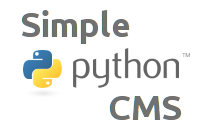Installation - Ubuntu ab Version 12.4¶
Ab Ubuntu 12.4 lassen sich die wenigen notwendigen Pakete sehr einfach installieren. Und Ubuntu-Upstart ist ideal dafür geeignet, eine “Simple Python CMS”-Instanz mit wenig Aufwand als Dienst laufen zu lassen.
Kurzanleitung¶
Die benötigten Programmpakete werden mit folgenden Befehlen auf der Kommandozeile installiert:
sudo apt-get install python-dev build-essential python-pip python-cherrypy3 python-snappy
sudo pip install jsonlib2
sudo pip install Mako
sudo pip install isodate
sudo pip install python-simplecms
Die Details der Installation und die Erstellung einer “Simple Python CMS”-Instanz werden in den nächsten Kapiteln erklärt.
Python 2.x¶
Informationen zu Python: http://www.python.org/
Python 2.7 ist bei Ubuntu 12.4 und 12.10 bereits installiert. Es müssen nur noch die Entwicklerpakete (dev) installiert werden, damit Mako und jsonlib2 (siehe weiter unten) kompiliert werden können.
sudo apt-get install python-dev build-essential
CherryPy Webframework¶
Informationen zu CherryPy: http://www.cherrypy.org/
sudo apt-get install python-cherrypy3
Mako Vorlagen¶
Informationen zu Mako: http://www.makotemplates.org/
Für die Installation von Mako müssen vorher die Pakte build-essential und python-dev installiert werden.
sudo pip install Mako
ISO-Date¶
Python-Modul zum Parsen von Datum und Zeit im ISO 8601 Format. Informationen zu isodate: https://pypi.python.org/pypi/isodate
sudo pip install isodate
Snappy Kompressionstool¶
Informationen zu Snappy: http://code.google.com/p/snappy/
sudo apt-get install python-snappy
Simple Python CMS¶
Die Installation von “Simple Python CMS” geht mit pip leicht von der Hand.
sudo pip install python-simplecms
“Simple Python CMS”-Instanz erstellen¶
Ubuntu-Upstart-Skript¶
Apache Reverse-Proxy¶
Information über Apache: http://httpd.apache.org/docs/2.2/
Falls bereits Apache als Webserver auf dem Computer eingesetzt wird, kann man den Apachen dazu verwenden, die Requests der Browser zur “Simple Python CMS”-Instanz weiterzuleiten. Dazu muss das Apache-Modul “proxy_http” aktiviert werden.
a2enmod proxy_http
Pound Reverse-Proxy¶
Informationen über Pound: http://www.apsis.ch/pound
